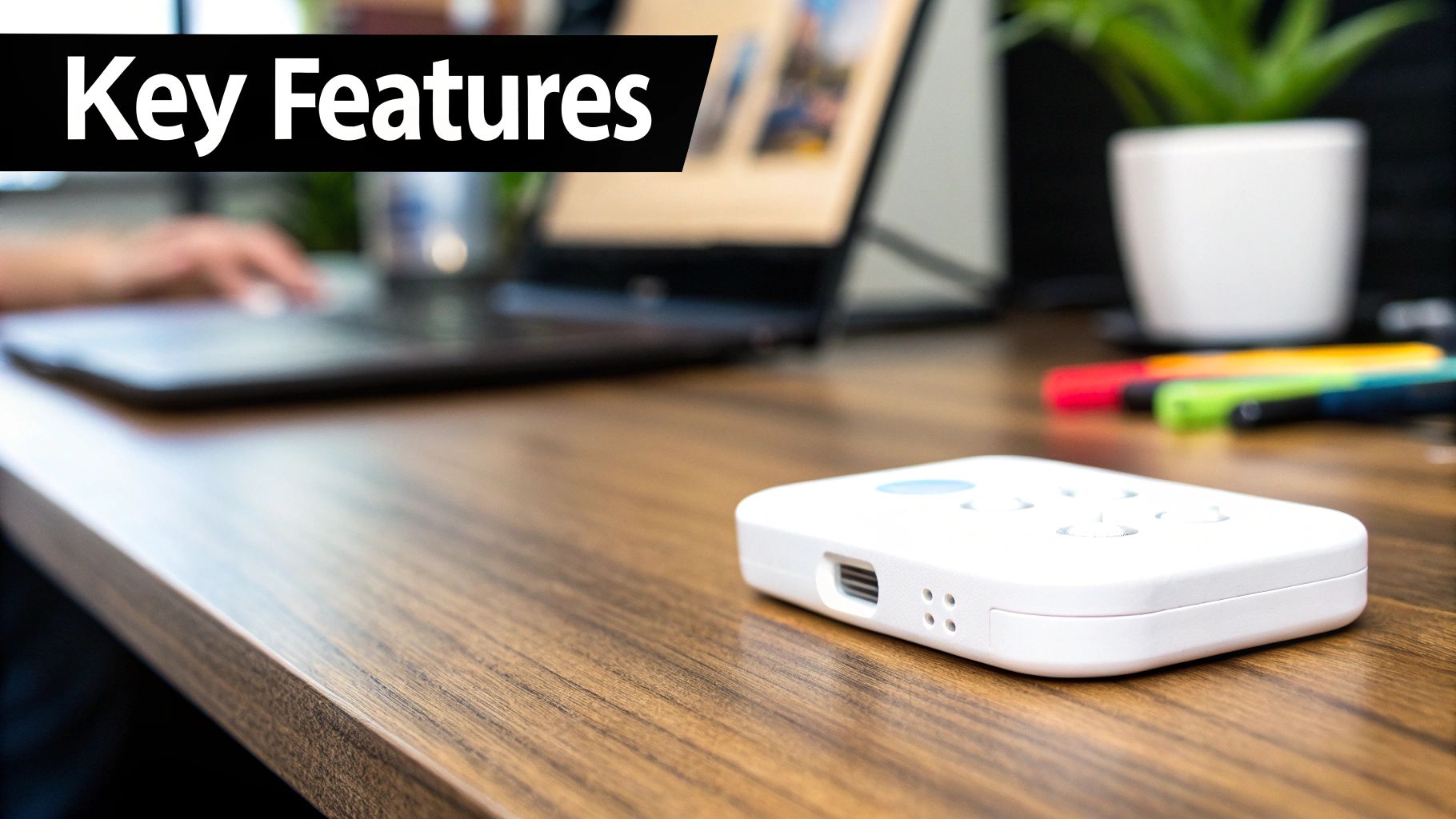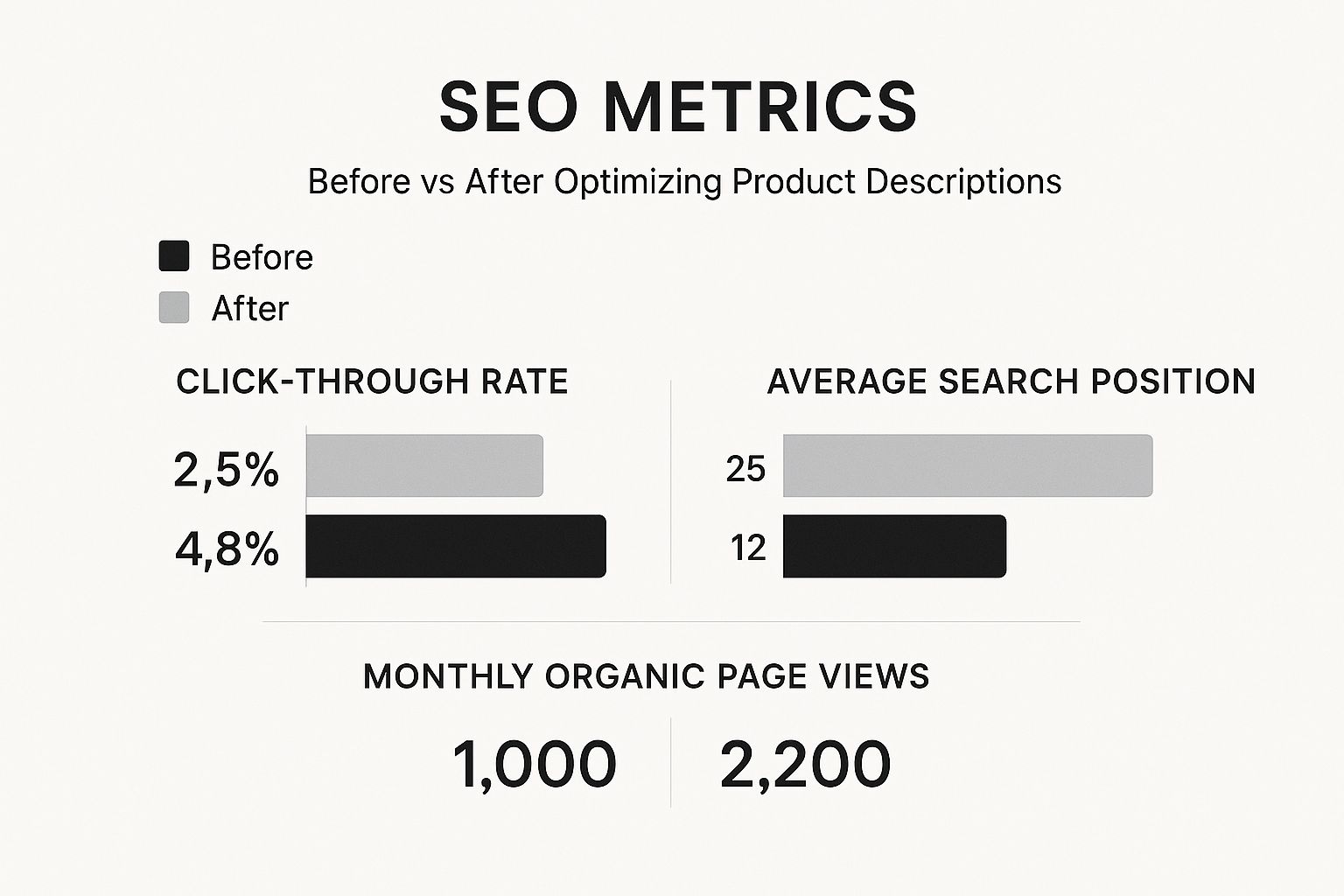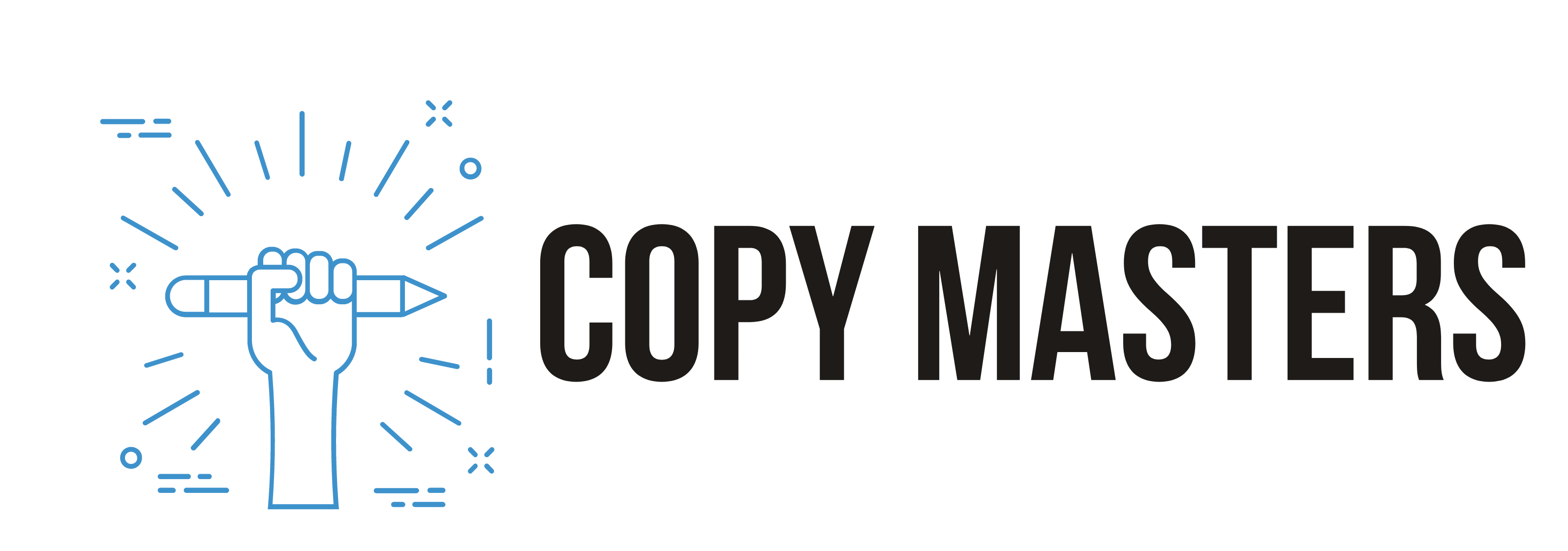Writing a great product description is all about making a genuine connection. You have to go beyond just listing out features and specs. The real magic happens when you translate those dry facts into tangible benefits that resonate with your customer’s wants and needs. It’s a mix of smart psychology, persuasive language, and clean, scannable formatting that turns a simple description into your best salesperson.
Why Your Product Descriptions Matter More Than Ever
Let’s be honest—most people treat product descriptions like a chore. It's often the last thing on the to-do list when adding a new item to the store. So, they just slap on some dimensions, list the materials, and call it a day. Big mistake.
Think of your product description as your silent, 24/7 sales superstar. It's always on, building trust with shoppers, answering their questions before they even think to ask, and creating an emotional spark that makes them want to buy.
In a brick-and-mortar shop, customers can hold the product, feel its weight, and chat with a helpful employee. Your product description has to do all that heavy lifting online. It’s the critical link between someone just browsing and someone clicking "Add to Cart."
The True Business Impact of Great Copy
The words you choose have a direct, measurable impact on your sales. This isn't just a gut feeling; the data backs it up. Consider this: over 80% of consumers do their homework online before making a purchase, and nearly 90% say product content is extremely important to their decision.
Even worse, bad descriptions lead to lost revenue. Around 64% of customers return items bought online simply because the description was poor or misleading. That's a huge, preventable loss.
This really drives home one crucial point: a great description removes friction from the buying journey.
- It builds confidence: When you clearly explain the benefits, you reassure customers they're making a smart choice.
- It lowers return rates: Clear, accurate information means fewer surprises and less disappointment, which saves you a ton of money and headaches.
- It creates brand loyalty: When you speak your customer's language and show you understand their problem, you create a memorable, trustworthy brand.
A product description isn't just metadata for your ecommerce site; it's a conversation with your customer. When done right, it answers their unspoken questions, validates their needs, and guides them confidently to the "add to cart" button.
To see the bigger picture, think about how descriptions fit into an effective ecommerce content strategy that sells. They aren't just isolated chunks of text. They are key assets that fuel sales and engagement across your entire digital storefront. Investing time here isn’t just about writing copy—it’s about building a more profitable, reputable brand.
The Essential Research Before You Write Anything

Here's a hard truth: great product descriptions don’t just happen. They aren’t born from a sudden flash of creative genius. Instead, they’re built on a solid foundation of research—understanding who you're talking to and what they're already hearing from your competitors.
Jumping straight into writing is like trying to build a house without a blueprint. You might get some walls up, but it's not going to be stable, and it definitely won't be what the buyer wanted.
This initial research phase is all about gathering the raw materials for copy that truly connects. You're hunting for the exact language, pain points, and desires of your target audience. It's the difference between a generic, forgettable description and one that feels like a one-on-one conversation with your ideal customer.
With the global content writing services market expected to hit USD 35.63 billion by 2032, it's clear that high-quality, targeted copy is more critical than ever. Product descriptions make up the biggest slice of that pie for a reason—they sell.
Build Your Ideal Customer Persona
You can't persuade someone you don't know. That’s where an ideal customer persona comes in. It's a detailed profile of your target buyer, but it goes way beyond basic demographics like age and location. The real gold is in their psychographics—their motivations, their frustrations, and what a typical day looks like for them.
To build a persona that actually helps, try to answer these questions:
- What are their biggest daily challenges? Think about the real-world problems your product solves for them, both big and small.
- What do they aspire to? What does "better" look like in their life? Your product is just a tool to help them get there.
- What language do they use? Eavesdrop on them. Read reviews, forums, and social media comments to pick up on their specific words and slang.
- What triggers them to buy? Is it a need for convenience? A desire for status? A passion for sustainability?
A great customer persona isn't just a document you create once and forget about. It's a living tool that should guide every single copywriting decision you make.
Think about it. If you're selling a high-performance, waterproof backpack, you wouldn't use the same description for everyone. A "Weekend Adventurer" persona means you'll talk about durability on rugged trails and keeping gear dry in a downpour. But for a "Daily Commuter" persona, the focus shifts to laptop protection, smart organization, and comfort during rush hour. Same product, two different worlds, two completely different descriptions.
This level of detail is a cornerstone of effective content creation, which is especially important for growing brands. For a deeper dive, check out our guide on https://copymasters.co/content-marketing-for-small-business/.
Analyze Your Competitors
Once you know who you’re talking to, you need to see what your competitors are saying to them. This isn't about stealing their ideas. It's about finding gaps and opportunities to do it better. Start by pulling up the product pages for three to five of your top rivals.
Look for patterns. How do they structure their descriptions? Do they lead with a story, a bulleted list of features, or a bold promise? What's their tone of voice—is it playful, technical, luxurious, or straight to the point?
While you're sizing them up, ask yourself:
- What are they doing well? Maybe their product photography is stunning or they have a brand story that really pulls you in. Take inspiration from what works.
- Where are they falling short? Are their descriptions just a boring list of specs? Is the formatting a massive wall of text? These weaknesses are your openings.
- What are their customers asking? This is a goldmine. Dig into their customer reviews and Q&A sections. Every unanswered question or repeated complaint tells you exactly what information you need to include in your copy.
Finally, a huge part of this research is getting a handle on how to keyword research. Understanding the actual terms people are typing into Google allows you to weave that language directly into your descriptions, ensuring your product gets found in the first place. All this prep work gives you the clarity you need to write product descriptions that don't just inform—they convert.
Turning Dry Features Into Compelling Benefits

Here’s a classic marketing truth you've probably heard: people don't buy a drill because they want a drill. They buy a drill because they want a hole. This simple idea is the absolute key to transforming your product descriptions from a snoozefest of specs into a powerful sales tool.
Customers don't actually buy features; they buy the benefits those features create in their lives. A feature is just a factual statement about your product—what it is or what it has. A benefit, on the other hand, is the positive outcome or feeling a customer gets because of that feature.
Your job is to build that bridge. You need to connect the dots for your customer so they can clearly see how your product makes their life better, solves their problem, or helps them hit a goal.
The 'So What?' Technique
The single most powerful tool I've ever used for this is asking one simple question over and over again: "So what?" This little question forces you to dig past the technical jargon and get to the emotional core. It’s the engine that turns dry facts into desirable outcomes.
Let’s run a real-world example through the "So What?" machine. Imagine a travel backpack.
- Feature: It’s made from ripstop nylon.
- So what? That means it's incredibly durable and won't easily tear.
- So what? This ensures your gear stays protected, even if the bag gets snagged on a branch or tossed around by baggage handlers.
- So what? You can travel with peace of mind, knowing your expensive camera and laptop are safe from accidents.
See how that works? We went from a boring material ("ripstop nylon") to a powerful emotional benefit ("travel with peace of mind"). That final benefit is what a customer is actually buying.
The "So What?" test is your secret weapon. Apply it to every feature on your list. If the final answer doesn't connect to a customer's desire for happiness, convenience, security, or status, keep digging.
This distinction is central to all persuasive writing. It’s a key difference you'll see highlighted when exploring copywriting vs content writing. Content often informs, but strong copywriting—the kind you need in a product description—has to persuade.
From Logic to Emotion with Storytelling
Once you’ve uncovered your benefits, you can start weaving them into a mini-story. Humans are just wired for stories. A narrative helps customers mentally place the product into their own lives, creating a powerful emotional connection that a bulleted list of specs simply can't touch.
Don't just state the benefit; paint a picture with your words. Use sensory language that helps them see, feel, or even smell the experience.
Let's look at another example for a high-end coffee maker.
Feature-Focused Description (The "Before"):
- Dual-boiler system
- PID temperature control
- Stainless steel construction
This is cold, uninspiring, and only speaks to coffee nerds. Now, let’s inject some benefit-driven storytelling.
Benefit-Focused Description (The "After"):
- Imagine waking up to the rich, intoxicating aroma of a perfectly pulled espresso shot, right in your own kitchen. Our dual-boiler system means no more waiting between brewing and steaming—you can craft a silky, cafe-quality latte in under a minute. Finally, you can be your own barista and savor that perfect morning moment without ever leaving home.
This version sells an experience, not just a machine. It taps into the customer's desire for convenience, quality, and a better morning routine.
Crafting a Persuasive Narrative
To pull this all together, you need a structure that’s both persuasive and easy to scan. One of the most successful methods is to clearly present both the features and their corresponding benefits, so the customer gets both the technical details and the real-world value.
Here's how to structure your description to be both persuasive and scannable:
- Lead with a Compelling Hook: Start with your most powerful benefit. Grab their attention immediately by speaking directly to their main pain point or desire.
- Expand with a Narrative Paragraph: Use 2-3 sentences to tell a mini-story, just like we did with the coffee maker. Help them visualize using the product.
- Use Bullet Points for Scannability: List your top 3-5 feature-benefit pairs in a bulleted list. This makes the key information easy to digest for people who are just scanning the page.
Here’s a quick template for your bullet points:
- [Feature Name]: [Benefit-focused explanation]. Example: Water-Resistant Canvas: Carry your essentials with confidence, knowing a sudden downpour won't ruin your day.
- [Feature Name]: [Benefit-focused explanation]. Example: Dedicated Laptop Sleeve: Cradles your tech in a padded compartment, so you can navigate crowded commutes without worrying about bumps and scratches.
This approach gives you the best of both worlds. The narrative creates an emotional connection, while the scannable list provides the logical backup a customer needs to feel confident in their purchase. It's this blend of art and science that turns a simple product page into a conversion machine.
Optimizing for Search Engines and Real People

So, you’ve turned a list of dry features into genuine, compelling benefits. You've even crafted a story that speaks directly to your ideal customer. But what's the point of a masterpiece if it's hanging in a gallery nobody can find?
This is where the art of persuasive writing bumps into the science of Search Engine Optimization (SEO). It's a delicate dance. You have to write for the search algorithms that decide your ranking, but you also have to write for the actual person who's going to read your words and hopefully click "buy."
If you over-optimize for the bots, your copy will sound clunky and robotic. But if you ignore them completely, you might as well be invisible. The trick is to see SEO as giving Google a set of clear, helpful signposts that point straight to your product page.
Finding the Keywords Your Customers Actually Use
Good SEO always starts with keyword research. Don't let that term scare you off—it's just about figuring out the exact words and phrases your customers are typing into Google when they need a product like yours.
You’re basically hunting for two different types of keywords:
- Head Terms: These are the big, broad keywords, usually just a word or two long. Think "hiking backpack" or "waterproof jacket." They get tons of traffic, but the competition is fierce.
- Long-Tail Keywords: These are much more specific phrases, like "lightweight waterproof backpack for thru-hiking" or "men's insulated jacket with hood." The search volume is lower, but the person searching knows exactly what they want, which often means they're much closer to making a purchase.
Once you have your list, gently sprinkle these keywords throughout your description. I always tell my clients to put their main keyword in the product title, the very first paragraph, and at least one subheading. After that, you can weave your other supporting keywords into the main body copy and bullet points.
The secret to effective SEO is writing for humans first. When your copy is clear, helpful, and answers a real person's questions, search engines notice. Google's entire mission is to provide the best answer to a query, and high-quality, user-focused content always wins.
Structuring Your Page for Scannability and SEO
Let's be honest: nobody wants to read a giant wall of text online. This is especially true on a phone, where over 70% of online shopping now takes place. People scan. They jump from headings to bullet points to bolded text, looking for the information they need right now.
This scanning behavior is actually a gift for your SEO. A well-structured page that’s easy to scan is also way easier for search engine crawlers to understand and index.
Here’s a simple structure that works wonders:
- Use a Clear Product Title: Your main heading (the H1 tag) should be the product name plus your primary keyword. Something like, "The Nomad 45L Weatherproof Travel Backpack."
- Break Up Text with Subheadings: Use H2 or H3 tags to create logical sections. These are perfect spots for secondary keywords, like "Designed for Rugged Adventures" or "Smart Organization for Daily Commutes."
- Lean on Bullet Points: Lists are your best friend. They highlight key features and benefits in a super scannable format and give you another natural place to include keywords.
- Emphasize with Bold Text: Bolding key phrases doesn't just catch the reader’s eye; it also sends a little signal to search engines that this information is important.
By blending the right keywords with smart, scannable formatting, you create a product page that serves two masters. It gives Google the ranking signals it needs while giving customers a clear, persuasive experience that moves them toward the checkout. If you're looking to really dig in, you can find more strategies for improving search engine rankings in our more detailed guide. This dual focus is the key to turning clicks into customers.
Using AI as Your Creative Copilot
Let's get one thing straight: artificial intelligence isn't going to replace your creativity. But it can be an incredible partner for sharpening your ideas and making the whole writing process faster. The trick is to treat AI writing tools like a strategic assistant, not some magic button that spits out perfect copy.
When you use it right, AI is a fantastic way to brainstorm new angles, smash through writer's block, and quickly generate different versions of copy you can test.
The idea isn't to let a machine create generic, soulless descriptions. It’s about using these powerful tools to help you refine your own authentic brand voice and polish your work until it truly shines. Think of it as having a junior copywriter at your beck and call—they can handle the rough drafts so you can focus on adding that final, human touch.
Prompting AI for Better Results
The quality of what you get out of an AI tool is a direct reflection of what you put in. Vague prompts get you vague, useless results. If you want copy that actually sounds human and fits your brand, you have to give the AI specific, detailed instructions.
Don't just say, "Write a product description for a new hiking boot." That's a recipe for generic fluff.
Instead, try something with a lot more meat on its bones:
"Act as a senior copywriter for an outdoor gear brand that targets millennial adventurers. Our brand voice is encouraging, knowledgeable, and slightly rugged. Write three unique product description options for our new 'Terra-Trekker' hiking boot. The key features are its Vibram sole for superior grip, GORE-TEX waterproofing, and lightweight design at only 1.2 lbs per boot. Focus on the benefits of all-day comfort, blister-free trails, and the confidence to tackle any terrain, rain or shine."
See the difference? This level of detail gives the AI the context it needs—your audience, your tone, and the specific value of your product. The drafts you get back will be worlds better and far more usable.
The image below really drives home the impact that well-written, optimized descriptions can have on your store's performance.

As you can see, simply optimizing your descriptions can more than double your organic page views and give a serious boost to your search rankings and click-through rates.
Specific AI Use Cases for Product Copy
An AI assistant can do way more than just write a first draft. It's brilliant at handling specific, targeted tasks that can take your descriptions from just "good" to "great."
Here are a few practical ways I like to work AI into my process:
- Brainstorming Unique Angles: Feeling stuck? Ask the AI to generate five different "hooks" or opening lines for your product, with each one focused on a different customer pain point.
- Translating Jargon: Copy and paste a list of your product's technical specs and ask the AI to translate them into customer-friendly benefits.
- Refining Tone of Voice: Got a draft you're not totally happy with? Give it to the AI and ask it to rewrite it in a different tone—maybe "more playful," "more luxurious," or "more professional and direct."
- Creating Variations for A/B Testing: Once you have a description you like, ask the AI to create two alternative versions with different headlines or calls to action so you can test which one converts better.
Comparing AI Writing Assistants for Product Descriptions
Choosing the right AI tool can feel overwhelming, but they each have their own strengths. Here's a quick rundown of some popular options and what they're best for when it comes to e-commerce copywriting.
| AI Tool | Best For | Key Feature | Pricing Model |
|---|---|---|---|
| Jasper | Versatile copywriting & brand voice consistency | "Brand Voice" feature learns and mimics your style | Subscription-based |
| Copy.ai | Generating a high volume of creative ideas quickly | "Freestyle" tool for brainstorming unique angles | Freemium & Subscription |
| Writesonic | E-commerce specific templates & product features | Pre-built templates for product descriptions & ads | Freemium & Subscription |
| ChatGPT | In-depth conversational prompting & refinement | Advanced natural language understanding for detailed instructions | Freemium & Subscription |
Ultimately, the best tool is the one that fits your specific workflow and budget. I recommend trying out the free versions of a couple to see which one you click with. They can all be powerful assets for crafting compelling product descriptions.
This approach keeps you in the driver's seat while using the machine's speed to explore creative options you might not have thought of on your own. For anyone looking to really dig into this, it's worth exploring how you can use AI to boost marketing performance and make every word on your product pages count.
Answering Your Product Description Questions
Even when you have a solid game plan, certain questions always come up the moment you sit down to write. Getting good at writing product descriptions means knowing how to handle these common little roadblocks. This section is all about tackling those nagging questions with straight, practical answers so you can finish your copy with confidence.
Think of this as your go-to guide for those "what if" moments. We'll cover everything from the ideal word count to dealing with minimalist products that don't have a long list of features.
How Long Should a Product Description Be?
There's no magic number here. The right length really boils down to two things: product complexity and price point. It makes sense when you think about it—the more expensive or complicated something is, the more a customer needs to know before they feel good about buying it.
A simple, low-cost item like a funny coffee mug probably only needs 50-100 words. The decision to buy is fast and doesn't need much convincing.
On the other hand, a big-ticket item like a professional camera or some specialized software demands a much deeper dive. For these, you'll often see descriptions hitting 300-500 words, maybe even more. Your job is to anticipate and answer every possible question about its features, who it's for, and how it works to get over that buyer hesitation.
Here's a solid rule of thumb: Your description should be just long enough to answer every reasonable question a customer might have, and not one word more.
What if My Product Has Very Few Features?
This is a classic problem, especially for simple, design-focused products like a basic t-shirt or a delicate piece of jewelry. When you can't just list a bunch of technical specs, you have to completely shift your focus from the "what" to the "why" and the "how."
Stop talking about the product itself and start talking about the experience, the feeling, and the story around it.
- Lean into the Origin Story: Is it handmade by a local artisan? Tell that story. Does it use a unique, sustainable material? Talk about where it comes from and what makes that special.
- Sell the Vibe: Don't just call it a "silver necklace." Describe how it "catches the light for a subtle, elegant shimmer that pulls any outfit together, from a casual brunch to a night out."
- Focus on the Feeling: A plain cotton t-shirt isn't just fabric. It's the "soft, breathable comfort you'll live in all weekend" or the "perfect, durable staple for your minimalist wardrobe."
When the feature list is short, emotion and storytelling are your best friends.
Should I Use the Same Description on Different Platforms?
It's super tempting to write one amazing description and just copy-paste it everywhere—your website, Amazon, Etsy, social media. Don't do it. Each platform is its own little world with a different audience, different formatting quirks, and a unique search algorithm.
Pasting the same content across multiple sites can actually tank your visibility. Search engines like Google get confused about which page to show in the results, and often, none of them rank as well as they could.
Try this instead:
- Create a "Master" Description: Write one core version that has all your key benefits, features, and brand story. This is your foundation.
- Adapt it for Each Channel: Now, tweak that master copy for every marketplace. For Amazon, you’ll want to pack your bullet points with keywords. For Instagram, lead with a more personal, engaging hook. On your own website, you have more room to expand on your brand's mission.
- Vary Your Keywords: Do a little keyword research for each platform. The way people search on Etsy can be very different from how they search on Google.
Taking the time to tailor your content ensures your product is positioned to win, no matter where someone finds it.
How Do I Handle Technical Jargon?
Let's face it, for some products, the technical specs are not just unavoidable—they're a selling point for a certain type of buyer. The trick is to present that info without scaring off your less-technical customers. A layered approach works best here.
Kick off your description with benefit-focused, easy-to-understand language that speaks to everyone. Get them excited about what the product does for them.
Then, create a separate, clearly marked section like "Technical Specifications" or "Product Details" further down the page. Use something scannable, like a table or a simple bulleted list, to lay out all the jargon-heavy details.
This way, you're talking to two different shoppers at once. The everyday customer gets the persuasive story they need to make a decision, and the expert can easily scroll down to find the exact specs they're looking for.
Ready to turn your blog into a consistent source of traffic, leads, and sales? Copy Masters provides a complete SEO content solution, delivering 30 expertly crafted articles designed to help you dominate search results and build authority in your niche.
Discover how our proven system can fuel your growth at https://copymasters.co
- How to Measure Content Performance and Prove Its Value - August 26, 2025
- How to Create Engaging Content That Connects - August 25, 2025
- 8 Keyword Research Best Practices to Dominate SERPs in 2025 - August 24, 2025
